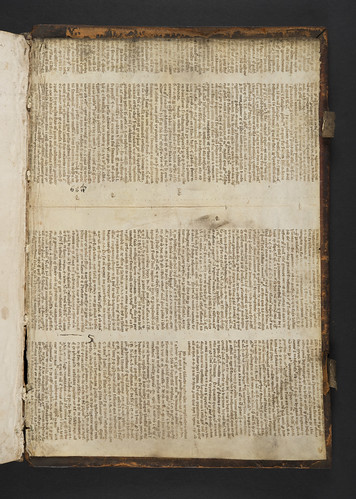Ludolphus de Saxonia: Vita Christi.
[Strassburg: Heinrich Eggestein], 1474.
Fol. Part I: [1-1510 168 17-1910 208]. [196] leaves. Part II: [1-1210 138 14-2010]. [198] leaves (20/10 blank).
ISTC il00337000; GW M19226; Goff L337; BMC I 75 (IC. 804); Bod-inc L-186; CIBN L-264; BSB-Ink L-259.
The Paris BN Rés. D. 663 copy was given by Eggestein to the Carthusian House in Strassburg. BMC (followed by Goff) originally suggested that the book might have been printed there. The Carthusians may have supplied the manuscript for printing: see Sack(Freiburg), 2281-3.
| GIP number: | L39 |
| Shelf-mark: | Sp Coll T.C.L. f10, 11 (see main library entry for this item) |
| Note: | The two parts bound separately. |
| Provenance: | Julius Echter von Mespelbrunn (1545-1617), Prince-Bishop of Würzburg - owner(?) or, more likely, simply a reference to him: inscription on 20/10v (f. 198v) of part II “Anno a Natiuitate d[omi]nj 1573 prima die Mensis De[ce]mb[ris] elect[us] est in Episcop[at]u[m] R[everen]dus in chr[ist]o D[omi]n[u]s Juli[us] echter ecclesiae Herbipol[en]sis [...] Decanus”. John Petheram (1807-1858), antiquary, publisher and bookseller, London: sold book to William Euing. William Euing (1788-1874), insurance broker, Glasgow: purchased from Petheram 10 July 1851 according to Euing’s pencil acquisition note and price code on front pastedown of vol. 2 “10 7 51 co/ Peth.”; early Euing inventory numbers “53” and “54” in pencil on front pastedowns. Free Church College Library, Glasgow (later Trinity College Library), founded 1856: presented by Euing, April 1867 (see GUL MS Euing 50); embossed stamp ‘Free Church College Library, Glasgow’ on 1/1 of part I and 1/1 of part II; various Trinity College Library shelfmarks ‘12/1’, ‘20/2 6’ and ‘40B/1’ in both volumes. Trinity College Library placed on permanent deposit in University of Glasgow Library in 1974 by the General Assembly of the Church of Scotland. |
| Binding: | Germany, 16th-century blind-tooled calf over wooden boards. Front cover of each volume decorated with fillets to form five concentric rectangles, the rear cover of each volume with three concentric rectangles. Although all the covers are heavily distressed, it is possible to partially identify some separate stamps – a diamond-shaped stamp containing a fleur-de-lys, a roundel containing a rosette, a shield containing a cross entwined with a branch of foliage, a small roundel containing a five-petalled flower, a scroll with indistinct lettering. Two brass fore-edge clasps on each volume (only the lower clasp of vol. 1 remains fully intact); catch plates on upper boards, each engraved with a scallop design; evidence of five bosses on all four boards (all now lost). Front pastedown of vol. 1 is of paper with a watermark visible of an elongated cross (similar to Heawood 910), and front flyleaf is of parchment with manuscript title in a 19th-century hand ‘Ludolphus Cartusianus in Vitam Jesu Christi volum: I’; rear pastedown of vol. 1 is part of a parchment bifolium from a liturgical manuscript, ruled and with text in double columns; rear flyleaf is a blank leaf of parchment. Front pastedown of vol. 2 is of parchment with the title ‘Ludolffus’ on the visible side and with a text in German on the now partially loose pasted side (the text includes a reference to ‘Graff Reinhard von Tierstein’); rear pastedown of vol. 2 is part of a parchment bifolium from an unidentified manuscript text – on canon law(?); no surviving front or rear flyleaves in vol. 2. Titles in ink on lower edge of text block of vol.1 ‘Ludolffus de Vita xpi p[ar]s p[ri]ma’, and of vol. 2 ‘Ludolffus de Vita xpi p[ar]s s[e]c[un]da’; numerous leather tabs (many dyed pink); 19th-century red leather title labels added to spines. Size: 410 × 290 mm. |
| Leaf size: | 397 x 285 mm. |
| Annotations: | Occasional marginal annotations and interlinear corrections; erasure in margin of 1/1r of part I - possibly an ownership inscription. |
| Decoration: | On 1/1r of part I a ten-line initial “F” is supplied in red with reserved white and embellished with brown pen-work; other principal initials supplied in red with reserved white, some with elaborate marginal flourishes; smaller initials supplied in plain red; capital strokes and underlining throughout in red; running chapter numbers and chapter headings in red; punctuation added in red throughout part I and at the beginning of part II. |
| Imperfections: | None. |





